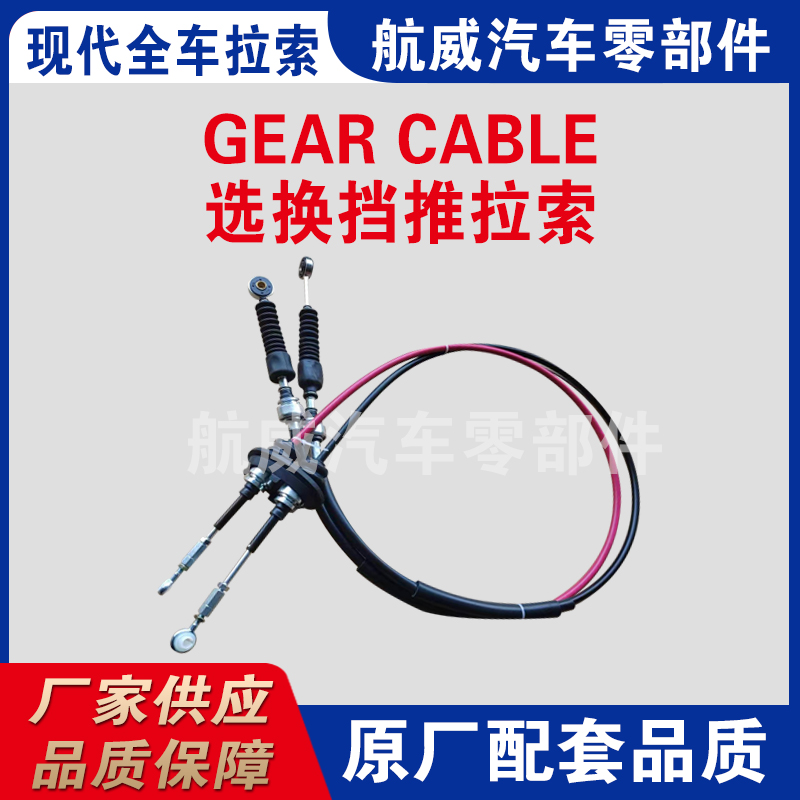Gear Cable for Smooth, Durable Shifting—Why Choose Us?
Shift Selector Cable: A Practical, Insider Look at modern driveline control
If you’ve ever felt a notchy shift or a vague selector gate, you already know how one small component can define the drive. The humble gear cable—in this case, the Shift Selector Cable from HWEI—keeps things precise. I’ve seen shops chase transmission faults for days, only to discover the cable was the quiet culprit. This unit comes out of Qinghe County Minjiang Street south, Wuzhishan Road east, and—credit where it’s due—feels engineered by people who’ve actually wrestled with real-world routing inside crowded engine bays.
Trend-wise, OEMs are pushing for lower shift effort, better NVH, and longer life under harsher duty cycles (think SUVs, delivery fleets, and, surprisingly, compact city cars that live with endless stop‑go). EVs haven’t killed the need either—park and mode selectors still rely on robust mechanical control in plenty of platforms. Actually, the new thing is stable friction over time; nobody wants a cable that starts light then turns gritty after one winter.

Core Specifications (typical)
| Construction | Bowden design: 7×7 stainless inner strand, PTFE-lined conduit, PA12/HDPE outer jacket |
| Outer Diameter | ≈ 7–10 mm (custom per routing) |
| Operating Temp | −40 ℃ to +120 ℃ (short peaks to +140 ℃) |
| Shift Effort | Low, stabilized friction (real‑world use may vary with routing) |
| Tensile Capacity | Up to ~1.5 kN depending on length/end fittings |
| Service Life | >200,000 shift cycles in lab benchmarks |
| End Fittings | Ball joints, clevis, eyelets, threaded M6/M8; boots & seals optional |
Materials, Methods & Testing
- Materials: SS304/316 inner wire; low-friction PTFE liner; abrasion‑resistant PA12/HDPE jacket; zinc‑nickel hardware.
- Methods: precision strand forming, swaged terminals, crimp validation, pre‑lubricated liner, 100% length/fit check.
- Testing: salt spray per ASTM B117 / ISO 9227; tensile per ISO 6892‑1 basis; thermal cycling; friction drift over cycles; dust/mud ingress checks.
- Quality: IATF 16949 and ISO 9001 systems; RoHS/REACH-compliant materials (on request).
Quick numbers from a recent batch: 480 h neutral salt spray (no red rust on hardware), friction drift
Where the gear cable earns its keep
- Passenger cars & light trucks: crisp PRND selection, reduced warranty callbacks.
- Off‑highway & AG: long runs, tight bends; routing support available.
- Marine throttles/selectors: corrosion‑resistant hardware options.
- Retrofit/aftermarket: custom lengths, brackets, and end fittings.

Customization & Process Flow
Spec your gear cable by stroke length, conduit OD, bend radius, terminal geometry, bracket interface, seals, and even color coding. Process flow: application study → CAD routing + DFM → sample build → bench validation → pilot run → PPAP (if needed) → series production, with traceability baked in.
Vendor Comparison (indicative)
| Vendor | Certifications | Customization Lead Time | Life Cycles (typ.) | Notes |
|---|---|---|---|---|
| HWEI Shift Selector Cable | IATF 16949, ISO 9001 | ≈ 2–4 weeks (samples) | ≥ 200k | Strong routing support; robust sealing options |
| Vendor A (Generic) | ISO 9001 | 3–6 weeks | 100–150k | Limited end fitting library |
| Vendor B (Import) | Unknown/varies | 4–8 weeks | 80–120k | Pricey rush orders; basic corrosion spec |
Real‑world note and a quick case
A regional delivery fleet swapped to this gear cable on a batch of vans—shift effort dropped by ~18% and mis‑select complaints fell almost overnight. After six months in salted roads, boots looked fresh; mechanics were, frankly, relieved.
Customers keep telling me the same thing: smooth from day one is nice; smooth after winter is what wins loyalty.
References
- IATF 16949:2016 – Automotive Quality Management Systems, IATF Global Oversight. https://www.iatfglobaloversight.org
- ISO 9227:2017 – Corrosion tests in artificial atmospheres — Salt spray tests, ISO. https://www.iso.org/standard/63543.html
- ASTM B117 – Standard Practice for Operating Salt Spray (Fog) Apparatus, ASTM International. https://www.astm.org/b0117-19.html
- Directive 2011/65/EU (RoHS), European Union. https://eur-lex.europa.eu
-
Clutch Line: Braided, Leak-Proof, OEM-Grade PerformanceNewsNov.10,2025
-
Throttle Cable: Durable, Smooth Control & Universal FitNewsNov.10,2025
-
Throttle Cable: Durable, Smooth, Universal Fit, Easy InstallNewsNov.10,2025
-
Clutch Line: Durable, Leak-Proof, OEM-Grade PerformanceNewsNov.10,2025
-
Hand Brake Cable | Custom, Universal & Trailer SolutionsNewsNov.10,2025
-
Clutch Line: High-Pressure, OEM-Fit, Corrosion-ResistantNewsNov.03,2025
